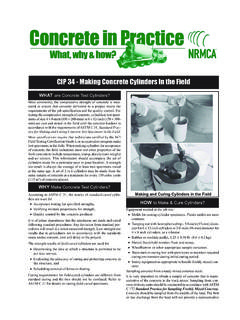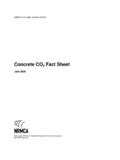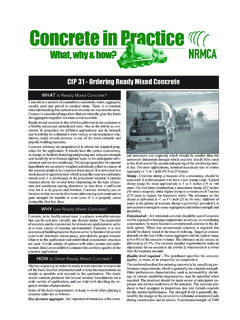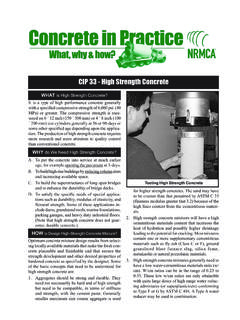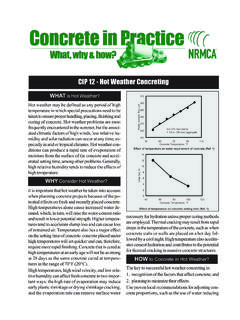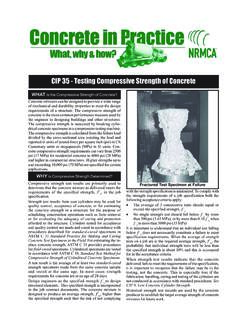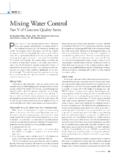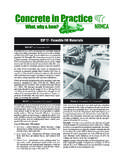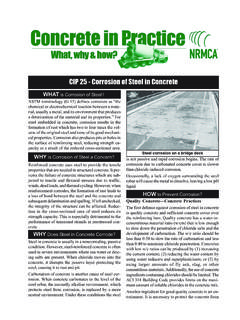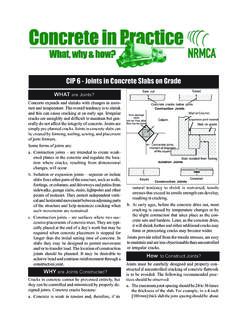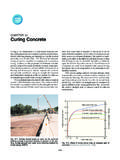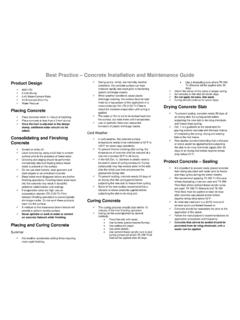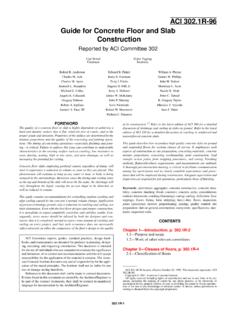Transcription of CIP 5 - Plastic Shrinkage Cracking
1 CIP 5 - Plastic Shrinkage Cracking WHAT is Plastic Shrinkage Cracking ? Plastic Shrinkage cracks appear in the surface of fresh concrete soon after it is placed and while it is still plas- tic. These cracks appear mostly on horizontal surfaces. They are usually parallel to each other on the order of 1 to 3 feet apart, relatively shallow, and generally do not intersect the perimeter of the slab. Plastic shrink- age Cracking is highly likely to occur when high evapo- ration rates cause the concrete surface to dry out be- fore it has set. Plastic Shrinkage cracks are unsightly but rarely impair the strength or durability of concrete floors and pave- Plastic Shrinkage Cracks ments. The development of these cracks can be mini- Conditions that cause high evaporation rates from the mized if appropriate measures are taken prior to and concrete surface, and thereby increase the possibility during placing and finishing concrete.
2 Of Plastic Shrinkage Cracking , include: (Note: Plastic Shrinkage cracks should be distinguished from other Wind velocity in excess of 5 mph early or prehardening cracks caused by settlement of the concrete around reinforcing bars, formwork movement, early age thermal Low relative humidity Cracking , or differential settlement at a change from a thin to a deep High ambient and/or concrete temperatures section of concrete.). Small changes in any one of these factors can signifi- WHY Do Plastic Shrinkage Cracks Occur? cantly change the rate of evaporation. ACI 305 pro- vides a chart to estimate the rate of evaporation and Plastic Shrinkage cracks are caused by a rapid loss of indicates when special precautions might be required. water from the surface of concrete before it has set. However, the chart isn't infallible because many fac- The critical condition exists when the rate of evapora- tors other than rate of evaporation are involved.
3 Tion of surface moisture exceeds the rate at which ris- ing bleed water can replace it. Water receding below Concrete mixtures with an inherent reduced rate of the concrete surface forms menisci between the fine bleeding or quantity of bleed water are susceptible to particles of cement and aggregate causing a tensile force Plastic Shrinkage Cracking even when evaporation rates to develop in the surface layers. If the concrete surface are low. Factors that reduce the rate or quantity of bleed- has started to set and has developed sufficient tensile ing include high cementitious materials content, high fines strength to resist the tensile forces, cracks do not form. content, reduced water content, entrained air, high con- If the surface dries very rapidly, the concrete may still crete temperature, and thinner sections.
4 Concrete con- be Plastic , and cracks do not develop at that time; but taining silica fume requires particular attention to avoid Plastic cracks will surely form as soon as the concrete surface drying during placement. stiffens a little more. Synthetic fiber reinforcement in- Any factor that delays setting increases the possibility corporated in the concrete mixture can help resist the of Plastic Shrinkage Cracking . Delayed setting can re- tension when concrete is very weak. sult from a combination of one or more of the follow- ing: cool weather, cool subgrades, high water contents, lower cement contents, retarders, some water reduc- e. Have proper manpower, equipment, and supplies ers, and supplementary cementing materials. on hand so that the concrete can be placed and finished promptly. If delays occur, cover the con- HOW to Minimize Plastic Shrinkage Cracking ?
5 Crete with moisture-retaining coverings, such as wet Attempts to eliminate Plastic Shrinkage Cracking by burlap, polyethylene sheeting or building paper, be- modifying the composition to affect bleeding charac- tween finishing operations. Some contractors find teristics of a concrete mixture have not been found to that Plastic Shrinkage cracks can be prevented in be consistently effective. To reduce the potential for hot dry climates by spraying an evaporation re- Plastic Shrinkage Cracking , it is important to recog- tardant on the surface behind the screeding op- nize ahead of time, before placement, when weather eration and following floating or troweling, as conditions conducive to Plastic Shrinkage Cracking needed, until curing is started. will exist. Precautions can then be taken to mini- f.
6 Start curing the concrete as soon as possible. Spray mize its occurrence. the surface with liquid membrane curing compound a. When adverse conditions exist, erect temporary wind- or cover the surface with wet burlap and keep it breaks to reduce the wind velocity over the surface of continuously moist for a minimum of 3 days. the concrete and, if possible, provide sunshades to con- g. Consider using synthetic fibers (ASTM C 1116) to trol the surface temperature of the slab. If conditions resist Plastic Shrinkage Cracking . are critical, schedule placement to begin in the later h. Accelerate the setting time of concrete and avoid afternoon or early evening. However, in very hot con- large temperature differences between concrete ditions, early morning placement can afford better con- and air temperatures.
7 Trol on concrete temperatures. If Plastic Shrinkage cracks should appear during final fin- b. In the very hot and dry periods, use fog sprays to ishing, the finisher may be able to close them by refinish- discharge a fine mist upwind and into the air above ing. However, when this occurs precautions, as discussed the concrete. Fog sprays reduce the rate of evapo- above, should be taken to avoid further Cracking . ration from the concrete surface and should be con- tinued until suitable curing materials can be applied. References 1. Hot Weather Concreting, ACI 305R, American Concrete In- c. If concrete is to be placed on a dry absorptive stitute, Farmington Hills, MI. subgrade in hot and dry weather, dampen the 2. Guide for Concrete Floor and Slab Construction, ACI , subgrade but not to a point that there is freestand- American Concrete Institute, Farmington Hills, MI.
8 Ing water prior to placement. The formwork and 3. Standard Practice for Curing Concrete, ACI 308, American reinforcement should also be dampened. Concrete Institute, Farmington Hills, MI. d. The use of vapor retarders under a slab on grade 4. Concrete Slab Surface Defects: Causes, Prevention, Repair, IS177, Portland Cement Association, Skokie, IL. greatly increases the risk of Plastic Shrinkage crack- 5. Bruce A. Suprenant, Curing During the Pour, Concrete Con- ing. If a vapor retarder is required, cover it with a 3 to struction, June 1997. 4 inch lightly dampened layer of a trimable, compact- 6. Eugene Goeb, Common Field Problems, Concrete Construc- ible granular fill, such as a crusher-run material. tion, October 1985. Follow These Rules to Minimize Plastic Shrinkage Cracking 1. Dampen the subgrade and forms when conditions for high evaporation rates exist.
9 2. Prevent excessive surface moisture evaporation by providing fog sprays and erecting windbreaks. 3. Cover concrete with wet burlap or polyethylene sheets between finishing operations. 4. Use cooler concrete in hot weather and avoid excessively high concrete temperatures in cold weather. 5. Cure properly as soon as finishing has been completed. 1978, 1992 AND 1998.
